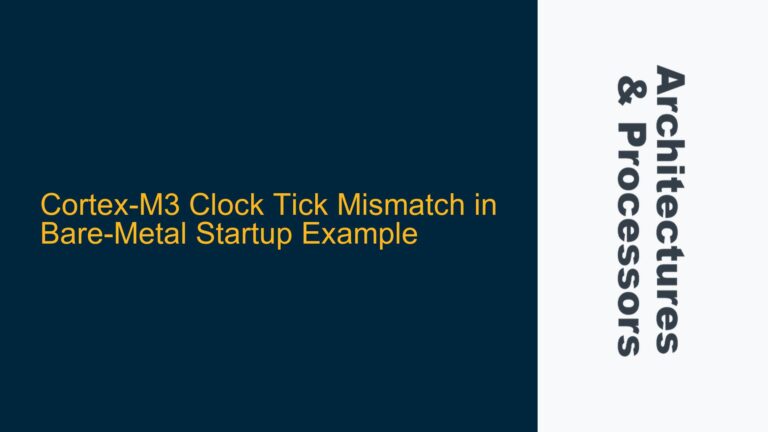ARM Function Return Value Handling in Assembly
In ARM architecture, the handling of return values from functions is a fundamental aspect of the Application Binary Interface (ABI). The ARM ABI defines a set of rules that govern how function calls are made, how parameters are passed, and how return values are handled. Understanding these rules is crucial for writing efficient and correct assembly code, especially when interfacing between high-level languages like C and assembly.
When a function in C returns a value, the ARM architecture typically uses registers to pass this value back to the caller. For simple data types like integers, the return value is usually placed in the R0 register. This is part of the ARM Procedure Call Standard (AAPCS), which specifies that R0 is used for the return value of functions that return a single word-sized value (32 bits on ARM).
For example, consider the following C function:
int func(int a) {
int x = a + 1;
return x;
}
In ARM assembly, this function might be implemented as follows:
func:
ADD R0, R0, #1 ; Add 1 to the input parameter a (stored in R0)
BX LR ; Return to the caller, with the result in R0
Here, the input parameter a is passed in the R0 register, and the result of the addition is also placed in R0 before the function returns. The BX LR instruction is used to return to the caller, where LR (Link Register) holds the return address.
For functions that return larger data types, such as 64-bit integers or structures, the return value may be handled differently. For example, a 64-bit integer might be returned in the R0 and R1 registers, with the lower 32 bits in R0 and the upper 32 bits in R1. Structures that are too large to fit in registers are typically returned in memory, with the caller providing a pointer to the memory location where the return value should be stored.
ARM Procedure Call Standard (AAPCS) and Return Value Conventions
The ARM Procedure Call Standard (AAPCS) defines the conventions for how function calls are made in ARM architecture, including how return values are handled. The AAPCS is part of the ARM ABI and is essential for ensuring compatibility between different compilers and libraries.
According to the AAPCS, the return value of a function is typically placed in the R0 register for a single word-sized value. For larger return values, such as 64-bit integers or structures, the return value may be split across multiple registers or returned in memory.
For example, consider a function that returns a 64-bit integer:
long long func(int a) {
long long x = (long long)a * 2;
return x;
}
In ARM assembly, this function might be implemented as follows:
func:
MOV R1, R0, LSL #1 ; Multiply a by 2 and store the lower 32 bits in R1
MOV R0, #0 ; Clear R0 for the upper 32 bits
BX LR ; Return to the caller, with the result in R0 and R1
Here, the lower 32 bits of the 64-bit result are placed in R1, and the upper 32 bits are placed in R0. The BX LR instruction is used to return to the caller.
For structures that are too large to fit in registers, the caller typically provides a pointer to a memory location where the return value should be stored. The function then writes the return value to this memory location before returning.
For example, consider a function that returns a structure:
struct Point {
int x;
int y;
};
struct Point func(int a) {
struct Point p;
p.x = a;
p.y = a + 1;
return p;
}
In ARM assembly, this function might be implemented as follows:
func:
LDR R1, [SP, #0] ; Load the pointer to the return structure from the stack
STR R0, [R1, #0] ; Store the x value in the structure
ADD R2, R0, #1 ; Calculate the y value
STR R2, [R1, #4] ; Store the y value in the structure
BX LR ; Return to the caller
Here, the caller provides a pointer to the memory location where the return structure should be stored. The function then writes the x and y values to this memory location before returning.
Debugging and Optimizing Return Value Handling in ARM Assembly
When working with ARM assembly, it is important to ensure that return values are handled correctly according to the AAPCS. Incorrect handling of return values can lead to subtle bugs that are difficult to diagnose. Here are some common issues and how to address them:
-
Incorrect Register Usage: One common mistake is using the wrong register for the return value. For example, using
R1instead ofR0for a single word-sized return value can cause the caller to receive an incorrect value. To avoid this, always ensure that the return value is placed in the correct register according to the AAPCS. -
Missing Return Instruction: Another common mistake is forgetting to include the
BX LRinstruction at the end of the function. This can cause the function to continue executing beyond its intended end, leading to unpredictable behavior. Always ensure that the function includes a return instruction. -
Incorrect Handling of Large Return Values: For functions that return large values, such as 64-bit integers or structures, it is important to ensure that the return value is handled correctly. For example, if a 64-bit integer is returned in
R0andR1, ensure that both registers are set correctly before returning. Similarly, if a structure is returned in memory, ensure that the structure is written to the correct memory location. -
Stack Alignment: The AAPCS requires that the stack be 8-byte aligned at function call boundaries. If the stack is not properly aligned, it can lead to issues with function calls and return value handling. Ensure that the stack is properly aligned before making function calls.
-
Debugging Tools: Use debugging tools such as ARM’s DS-5 or GDB to step through the assembly code and inspect the values of registers and memory. This can help identify issues with return value handling and ensure that the function behaves as expected.
By following these guidelines and understanding the AAPCS, you can ensure that return values are handled correctly in ARM assembly, leading to more reliable and efficient code.
Conclusion
Handling return values in ARM assembly requires a deep understanding of the ARM Procedure Call Standard (AAPCS) and the conventions for passing and returning values. By adhering to these conventions and using the correct registers and instructions, you can ensure that your assembly code interacts correctly with high-level languages like C. Additionally, careful debugging and optimization can help identify and resolve issues with return value handling, leading to more robust and efficient embedded systems.






